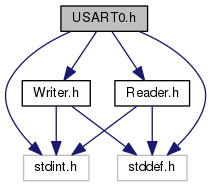This file provides functions that offer high-level interfaces to USART0 hardware, which is available on the Arduino Uno (ATmega328) and Arduino Mega (ATmega2560). More...

Go to the source code of this file.
Classes | |
| class | Serial0 |
| Provides a high-end interface to serial communications using USART0. More... | |
Namespaces | |
| namespace | USART0 |
| This namespace bundles a high-level buffered interface to the USART0 hardware. It provides logical cohesion and prevents namespace collisions. | |
Enumerations | |
| enum | UsartSerialConfiguration { kSerial_5N1 , kSerial_6N1 , kSerial_7N1 , kSerial_8N1 , kSerial_5N2 , kSerial_6N2 , kSerial_7N2 , kSerial_8N2 , kSerial_5E1 , kSerial_6E1 , kSerial_7E1 , kSerial_8E1 , kSerial_5E2 , kSerial_6E2 , kSerial_7E2 , kSerial_8E2 , kSerial_5O1 , kSerial_6O1 , kSerial_7O1 , kSerial_8O1 , kSerial_5O2 , kSerial_6O2 , kSerial_7O2 , kSerial_8O2 } |
| This enum lists serial configuration in terms of data bits, parity, and stop bits. More... | |
Functions | |
| void | USART0::start (unsigned long baudRate, UsartSerialConfiguration config=kSerial_8N1) |
| Initialize USART0 for buffered, asynchronous serial communications using interrupts. | |
| void | USART0::stop () |
| Stops buffered serial communications using interrupts on USART0. | |
| size_t | USART0::write (char c) |
| Write a single byte to the transmit buffer. | |
| size_t | USART0::write (const char *c) |
| Write a null-terminated string to the transmit buffer. | |
| size_t | USART0::write (const char *c, size_t n) |
| Write a character array of given size to the transmit buffer. | |
| size_t | USART0::write (const uint8_t *c, size_t n) |
| Write a byte array of given size to the transmit buffer. | |
| void | USART0::flush () |
| Flush transmit buffer. | |
| int | USART0::peek () |
| Examine the next character in the receive buffer without removing it from the buffer. | |
| int | USART0::read () |
| Return the next character in the receive buffer, removing it from the buffer. | |
| bool | USART0::available () |
| Determine if there is data in the receive buffer.. | |
Detailed Description
This file provides functions that offer high-level interfaces to USART0 hardware, which is available on the Arduino Uno (ATmega328) and Arduino Mega (ATmega2560).
These interfaces are buffered for both input and output and operate using interrupts associated with USART0. This means the transmit functions return immediately after queuing data in the output buffer for transmission and the transmission happens asynchronously, using dedicated USART0 hardware. Similarly, data is received asynchronously and placed into the input buffer.
The transmit and receive buffers are both ring buffers. If you try to queue more data than the transmit buffer can hold, the write functions will block until there is room in the buffer (as a result of data being transmitted). The receive buffer, however, will overwrite if it gets full. You must clear the receive buffer by reading it regularly when receiving significant amounts of data.
The sizes of the transmit and receive buffers can be set at compile time via macro constants. The default sizes are 32 bytes for the receive buffer and 64 bytes for the transmit buffer. To change these, define the macros USART0_RX_BUFFER_SIZE (for the receive buffer) and USART0_TX_BUFFER_SIZE (for the transmit buffer) to whatever sizes you need. You need to make these define these macros prior to compiling the file USART0.cpp.
Two interfaces are provided. USART0 is a functional interface that makes use of the buffering and asynchronous transmit and receive capabilities of the microcontrollers. However, USART0 is limited to transmitting and receiving byte and character streams.
Serial0 is the most advanced and capable interface to the USART0 hardware. Serial0 provides a object-oriented interface that includes the ability to read and write numbers of various types and in various formats, all asynchronously.
To use these functions, include USART0.h in your source code and link against USART0.cpp.
- Note
- Linking against USART0.cpp installs interrupt functions for transmit and receive on USART0 (interrupts USART_UDRE and USART_RX on Arduino Uno/ATmega328; interrupts USART0_UDRE and USART0_RX on Arduino Mega/ATmega2560). You cannot use the minimal interface to USART0 (from USARTMinimal.h) if you link against USART0.cpp. In particular, do not call initUSART0() or clearUSART0() if you link against USART0.cpp.
Enumeration Type Documentation
◆ UsartSerialConfiguration
This enum lists serial configuration in terms of data bits, parity, and stop bits.
The format is kSerial_XYZ where
- X = the number of data bits
- Y = N, E, or O; where N = none, E = even, and O = odd
- Z = the number of stop bits